Imagine a system where everyone benefits from a service, but no one has any incentive to pay for it. Economics students know this as the “free rider problem” — and Harvard has created a textbook example in its own backyard.
Each year, unless they opt out, the University charges Harvard College students a $200 Student Activities Fee — on top of nearly $80,000 for tuition and housing — that funds social programming on campus like Yardfest, Harvard’s annual spring concert, and student organizations.
The SAF needs a complete overhaul.
Under the current system, students have no incentive to pay the $200 fee, except for a vague sense of civic duty that they should contribute to Harvard’s culture of fun. Those who opt out are still able to receive funding for their student organizations and enjoy fun events, and those who do choose to pay may not reap the rewards of the fund at all. It should therefore come as no surprise that the total amount in the SAF fund for this academic year has decreased.
This decline is to the detriment of the entire community. The Harvard Undergraduate Association announced this week that, in part because so many students opted out of the SAF, they were only able to disburse 22 percent of the amount requested by student clubs.
But rather than addressing this funding crisis by acknowledging the free rider problem, Harvard’s administration has instead placed the blame on the students who chose to opt out of the fee. For example, in an interview with The Crimson last spring, Jason R. Meier, associate dean for student engagement, said that “students don’t realize, by opting out, they’re exacerbating this larger problem that we already have.”
HUA Co-Treasurer Tobias Elbs ’27 echoed this sentiment: if more students paid the fee, “we wouldn’t have to cut any club.” Even The Crimson’s Editorial Board seems to have determined that students should shoulder the responsibility, claiming that because clubs are a public good, “those who can pay the fee should do so.”
For many students, $200 is a significant sum — money that could cover textbooks, meals, or emergency expenses. The suggestion that students should voluntarily sacrifice this amount for the “greater good” is both unrealistic and unfair. It asks individuals to solve a structural problem that the institution itself has created.
Indeed, the fee is not covered by financial aid, which means that even students on a full ride are expected to pay out of pocket. And according to Dean of Students Thomas Dunne, students on financial aid do not opt out of the fee at a disproportionately higher rate. It seems the fee functions like a flat tax, where both rich and poor students are expected to pay the same amount.
Furthermore, while the fee might make sense as a funding source for individual College-wide events like Yardfest, it is not the right funding structure for student clubs. Unlike one-off events, these clubs are consistent, vital parts of student life: In the Crimson’s 2024 Senior Survey, 73 percent of surveyed students rated extracurricular activities as either “important” or “very important,” and students spent an average of 14.3 hours a week on activities.
Funding clubs through this fee almost certainly means that as more students opt out of the fee, club operations must scale down. It also discourages the creation of new clubs, as existing funding is already strapped. For a school like Harvard, where clubs are a disproportionately large part of students’ lives compared to other universities, this funding structure does not make sense.
Harvard seems to have a double standard when it comes to clubs: it wants to advertise and regulate them, but it doesn’t want to create infrastructure to fund them.
To justify the use of the SAF to fund clubs, Meier argued that because it comes from students, it allows organizations to remain independent of the University. But Harvard heavily regulates clubs and places restrictions on their external means of funding, for example, via restrictions on event sponsorship — in other words, they are not truly independent. Exhortations to“financial independence” avoid responsibility for creating a robust funding infrastructure.
The solution is straightforward: Harvard must save its student activities budget from the tragedy of the commons. Either make the fee mandatory and cover it through financial aid (as, e.g., Brown University does), or eliminate it entirely and fund clubs through the regular budget. Both options would eliminate the current regressive system and ensure a more stable source funding for clubs.
For an institution sitting on a $50 billion endowment, the current approach isn’t just poor economics — it’s an abdication of responsibility. Every time students raise concerns about Harvard’s failure to support its student organizations or the University’s lack of fun, administrators can point to the dwindling SAF.
But Harvard was the one to set up the flawed system in the first place. It’s time for the university to stop passing the buck to students and start investing in the organizations that make its community thrive.
Mukta R. Dharmapurikar ’26, a Crimson Editorial editor, is a double concentrator in Environmental Science and Engineering and Economics in Lowell House.

